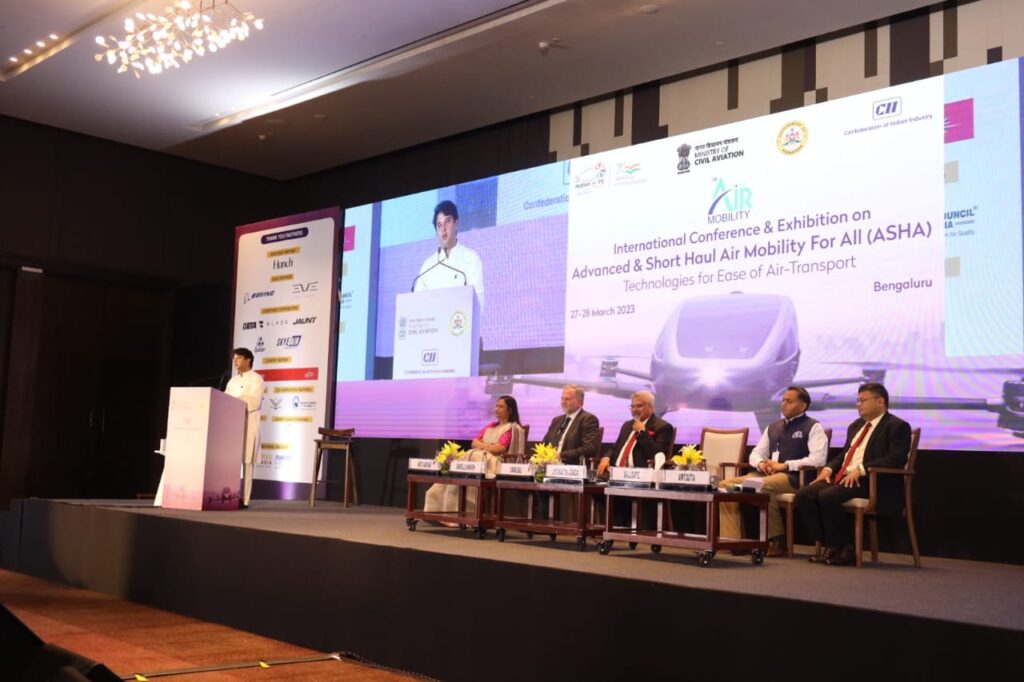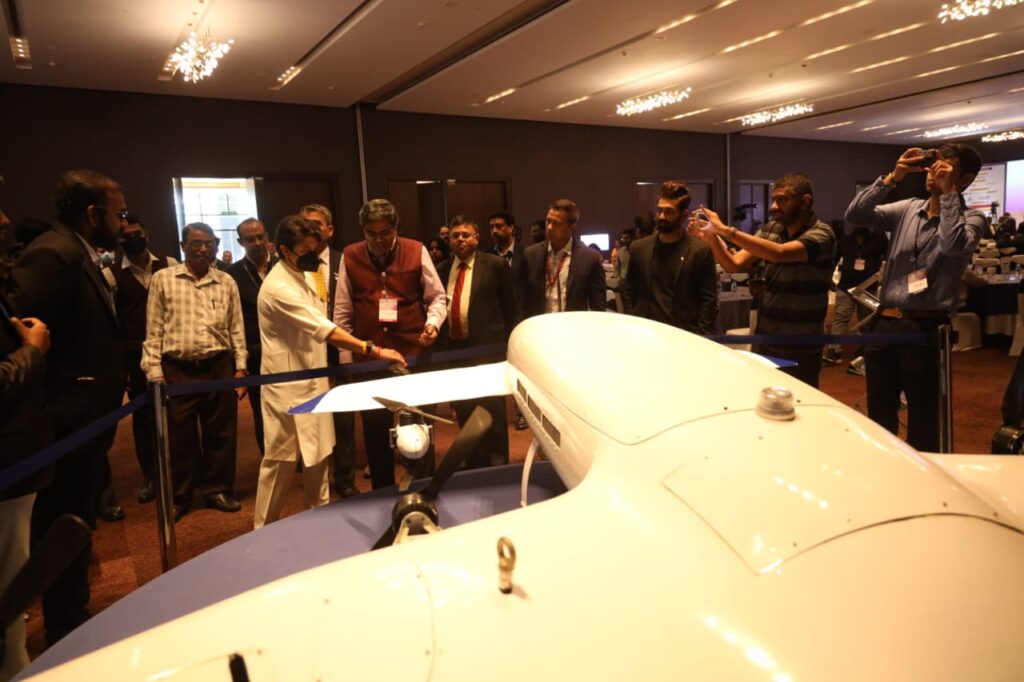India to become largest aviation market in a decade-Jyotiraditya Scindia
- India will have 1,200 planes with 40 crore air travellers by 2027, and 220 airports by the next 4-5 years,
- Minister invites global Companies to be part of India Journey
- Scindia delivers key-note address at the International Conference & Exhibition on Advanced & Short Haul Air Mobility for All (ASHA) in Bengaluru.
Bangalore, March 28. Union minister of civil aviation Jyotiraditya Scindia has said that India will become the largest civil aviation market in the next decade. The Minister informed that India has crossed the pre-COVID number of air travellers by 10 per cent to reach 4, 55,000 passengers daily, with airlines now operating at 80 to 90 per cent load factor. The penetration level in a population of 1.3 billion is, however, still three to five per cent. “We need more aircraft and more quickly because India has an insatiable desire to travel,” Scindia said.

He was delivering key-note address at the International conference on Advanced & Short-Haul Air Mobility for All (ASHA): Technologies for Ease of Transport, in Bengaluru, today.
India will have 1,200 planes with 40 crore air travellers by 2027, and 220 airports by the next 4-5 years, Union minister Jyotiraditya Scindia projected the country’s civil aviation sector to have a phenomenal and healthy growth in terms of passengers, aircraft and airports.
The union minister forecasted that by 2027 India will have 40 crore travellers in India (both domestic and international). That is the kind of growth potential we are looking at in terms of passengers.
As for the number of aircrafts, there were about 400 aircraft in 2013 and in 2021-22, the number rose to 700.
“We are going to add 15 per cent capacity or 100 to 110 aircraft per year. India is looking at close to 1,200 aircraft by 2027,” Scindia said and emphasised there is growth in the market, fleet and airports.
The minister further went on to say that, during 65 years there were only 74 airports and in the last 8 years, that number has gone up to 148 and is to go up to 220 airports by 2027-28.

“That is the phenomenal growth that you are going to see on infrastructure as far as airports are concerned, in terms of service capabilities, airlines and in terms of passengers,” Scindia said.
The aviation industry will continue to experience robust growth due to the rise in demand from India’s increasingly upward-mobile middle class. The government plans on turning India into an international aviation hub.
The civil aviation sector was significantly impacted by the coronavirus pandemic and is on the recovery path.The minister also said that the day is not far when the civil aviation sector will become a very strong foundation and bulwark of the transportation industry in India.
Minister of Civil Aviation, Jyotiraditya Scindia said that previous governments used to give hope, but nothing was being implemented. In the last eight years the Prime Minister Narendra Modi government has given unprecedented priority to the Country’s aviation sector.
It is the vision of the Prime Minster to provide air connectivity to each corner of the country and we are working in collaboration with each state to materialize it. Not only the major cities but the advanced landing grounds in the remote areas of tier 2 and tier 3 cities will also be connected, Scindia said.
The Minister exuded confidence that the country would become the largest market in the Civil Aviation by next one decade.
Adding on, the Minister for Civil Aviation said that India to become global drone hub by 2030.
India is a changed country now; we do not wait for someone to give us a global template that will get implemented as-is; instead, we are writing our own script. We are setting ambitious goals and creating paths to achieve these big results, he said.
The Country is always open to change and keen to adapt to anything new in technology and drones will not be an exception. Drones will play a big role in India’s ambition to reach a $5 trillion economy, as they are likely to create a positive impact across multiple segments of the Indian economy, Scindia added.
India is always open to change and keen to adapt to anything new in technology and drones will not be an exception. Drones will play a big role in India’s ambition to reach a $5 trillion economy, as they are likely to create a positive impact across multiple segments of the Indian economy.
Speaking about opportunities in the Advanced Air Mobility (AAM) sector, the minister said the drone market will become a three lakh crore rupees market by 2030 employing three to four lakh persons.
He stressed the need to have a good eco system and said AAM must have its basis in strong civil aviation infrastructure. For the Infrastructure to be built, the Minister said, urban city planners were needed to be involved. “Along with vertiports, we need to have charging points as well,” he said. “It is Prime Minister Narendra Modi’s aim to make India the global drone hub by 2030. NITI Aayog and the civil aviation ministry are working towards this,” the minister said.
“The PLI (production-linked incentive) scheme, which has been implemented under the leadership of PM Modi, will give a fresh boost to manufacturing and services in the drone sector,” Scindia added.
Rajiv Bansal, Secretary, Ministry of Civil Aviation, said that India wants to be part electric vertical take off and landing (eVTOL) aircraft dream along with the rest of the world that is planning to offer this innovative transportation technology by 2025.
Bansal, delivering the inaugural address at India’s first Advanced Air Mobility (AAM) conference said, “eVTOL’s future is not as far as it seems, it is much closer than what it appears, we are in 2023 and in 2025 this global dream will become a reality and India very much wants to be part of this global initiative.”
AAM is an air transportation system that moves people and cargo between short distances, otherwise not served or underserved by aviation using eVTOL.
eVTOL are also known as electric air taxi’s and countries like Singapore, UAE, France, Germany, UK and US have already announced their plans to launch these air taxis by 2025.
Bansal said that the eVTOL’s in India should be an industry-led initiative and asked the industry to give feedback on how to implement the eVTOL ecosystem in the country.
“We want to know what you (industry) want from us. What is it you want from the air traffic management as there is a lot of talk about manned and unmanned vehicles.
We also want to know what is happening globally; are there some protocols? What will be the responsibility of the DGCA, the Ministry of Civil Aviation and so on,” Bansal said.
Salil Gupte, President, Boeing India and chairman, CII National Committee, said, AAM can do to India’s transport what telephony did to its communications. In telecom India skipped stages where the rest of the world was stuck. We have seen India leapfrog from landline to mobile to 4G to 5G roll-outs at lightning speed, Mr. Gupte said. Later, three Memorandum of Understandings were signed with international leaders in AAM space to commit investment in India.





